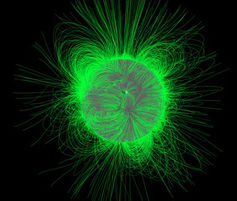Why is The Sun Going Quiet? (Op-Ed)


This article was originally published at The Conversation. The publication contributed the article to SPACE.com's Expert Voices: Op-Ed & Insights.
The sun is our nearest star and the source of all our light and heat on Earth but recent reports have highlighted an ongoing steep decline in solar activity.
This story is a reminder that our sun is a variable star whose dynamic production of magnetism, activity and winds have implications for our planet.
Solar magnetic fields power solar activity, including sunspots, explosive events known as solar flares and coronal mass ejections, and an outward-flowing solar wind.
The sun’s activity and wind bathes Earth in a changing space environment of high-energy radiation and fast-moving particles called “space weather”. This gives us both the beauty of the aurorae and disruptive effects on communications and other technology.
Solar activity varies over time, with the 11-year sunspot cycle being the most familiar example. Solar activity also varies more widely over longer timescales, producing “grand maxima” and “grand minima”.
The most famous of these is the Maunder minimum in sunspot activity from around 1645 to 1715.
Breaking space news, the latest updates on rocket launches, skywatching events and more!
The current rate and extent at which solar activity is falling has been interpreted as the beginning of another grand minimum, and raises the issue of what it means for Earth’s climate.
Variations in solar activity have long been linked to climate variability on Earth, with the most familiar historical example being the Maunder minimum. This corresponded to relatively cold climatic conditions described as the “Little Ice Age” when rivers that were normally ice-free froze and snow fields remained year-round at lower altitudes.
Question of how solar activity influences the Earth’s climate remains the subject of ongoing research. What is becoming clearer is that variations in solar ultraviolet radiation resulting from solar activity can provide a physical mechanism for the Sun to influence the Earth’s atmosphere.
However, it is important to understand that research also indicates that these solar effects are minor compared to modern-day anthropogenic effects. Even if there is measurable cooling, a grand minimum should not be relied upon to slow global warming.
Climatic effects aside, a grand minimum in solar activity would mean reduced auroral displays, and some lessening of the hazards caused by space weather for spacecraft, and any occupants.
Why the fluctuations?
The answer lies in how the sun generates its magnetic field.
As a typical star our sun is a ball of hot gas, more than a hundred times the diameter and hundreds of thousands of times more massive than the Earth.
Inside the sun, the effects of heat, pressure and motion produce electrical currents that in turn generate magnetic fields. This solar dynamo results in magnetic fields emerging from the sun’s visible surface to power its activity and winds and the space weather experienced by Earth.
Explaining the variable nature of solar activity comes down to understanding the physics of the solar dynamo. At present there is a general theoretical picture of how the dynamo can produce magnetic fields and even cycles.
What is less certain is how the dynamo changes into the special state that corresponds to grand minimum, and whether such occurrences are to some extent predictable or purely random.
One way to learn more about the sun and its dynamo is to study other stars. Dynamos occur in many other stars, so observations of stars of different ages can offer clues regarding the past and future of solar magnetism and its effects. These magnetic studies of stars and their activity and winds can be used to better test the predictions of dynamo theory.
An improved understanding of stellar dynamos may then help us know more about what is happening to the sun today, and perhaps provide a useful tool to forecast future changes in our variable sun.
Brad Carter is a member of the Bcool project studying stellar magnetic activity.
This article was originally published at The Conversation. Read the original article. The views expressed are those of the author and do not necessarily reflect the views of the publisher. This version of the article was originally published on SPACE.com.

Professor Brad Carter is the Director of the Centre for Astrophysics within USQ’s Institute for Advanced Engineering and Space Sciences. His research interests include stellar astronomy, planetary systems and astronomical instrumentation.


